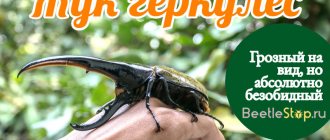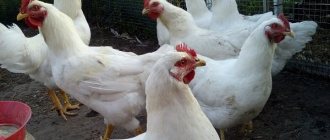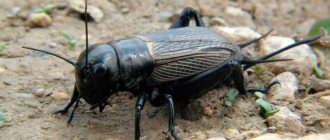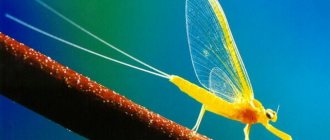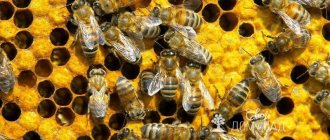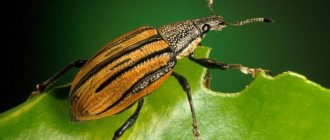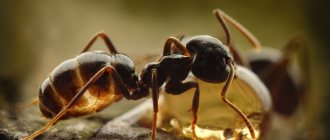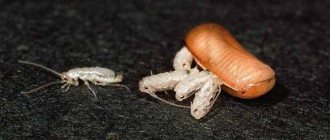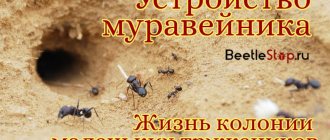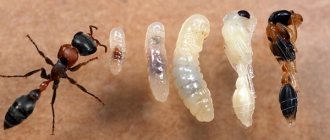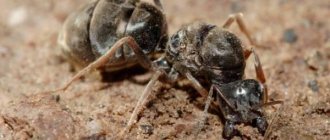Beetles are the most numerous group of insects. The number of existing species reaches 400 thousand. Among the representatives of the order Coleoptera there are many interesting specimens that cause surprise in appearance or behavior. The Hercules beetle is a recognized giant and strongman among its relatives. With a body length of up to 17 cm, it is the largest species of the Dynastes genus. The inhabitant of the tropics is completely safe, it feeds on ripe fruits.
Description of the species
The Hercules beetle (lat. Dynastes hercules) belongs to the lamellar family, genus Dynastes. Hollow beetles are the largest beetles, which are characterized by outgrowths on the head and pronotum of males. The head is small, the antennae consist of 10 segments, ending in a club. There are 300 rhinoceros beetles in this genus. Close relatives of Hercules include the scarab, elephant beetle, and rhinoceros beetle.
The body size of males is 125-145 mm, but sometimes reaches record levels of 171 mm, females are smaller - up to 80 mm. The body is black, covered with sparse red hairs. Like a typical representative of Coleoptera, its fore wings were transformed into solid elytra. In terms of strength, they are not inferior to the chitinous cover of the body. At rest, the elytra cover the mesonotum and the upper part of the abdomen.
Their color depends on the level of environmental humidity. The main color is olive, brown or yellow. It is complemented by black spots, the size and position of which can vary. There is a Hercules beetle with a bluish-gray or black elytra, such as in the photo. The adult can achieve a color change in just a few minutes. This amazing property of beetles has attracted the close attention of scientists. Rapidly reversible migrations of colored pigment in an insect's shell is a very rare ability.
The hind wings of insects have not atrophied; they can make short flights. The legs are long and have strong serrated claws that allow them to climb tree trunks. The fore tibia are digging, with their help the insect burrows into the leaf litter. When spread, the wingspan is 22 cm.
Interesting fact. Dynastes hercules amazes not only with its size, but also with its weight. How much does the Hercules beetle weigh? The weight of the imago reaches 110 g, the larvae - 100 g.
Sexual dimorphism
Males and females are noticeably different from each other. The male has a large black horn on his head, pointing forward. The end is curved upward and has several teeth on the surface. The second horn begins on the pronotum. Its length can exceed the size of the insect's body. The organ is also directed forward and curved downwards. Yellowish-brown hairs grow along the horn; there are two teeth on the front part.
Information. The size of the horns is an indicator of the male's physical health and nutritional quality.
The description of the female Hercules beetle differs significantly from the description of the male. Sometimes they are mistaken for beetles of different species. Females do not have horns. The color of the elytra is dark, the body is almost completely covered with red hairs. The size of the female individual is 70-80 mm, but they are inferior to males solely due to the lack of horns.
Interesting fact. The Hercules beetle was named for its extraordinary strength and endurance; it is believed that it can lift a load 800 times its weight. But this is just a myth; in fact, an insect with the name of an ancient Greek hero lifts up to 8 kg.
Beetle larva
The larva is large, C-shaped. The integument of the body is soft, sclerotized, covered with sparse hairs. At an early stage, the color of the body is white, but towards pupation it turns yellow. The head of the Hercules beetle larva is black and well developed. Its surface is textured and not smooth like other types. The body consists of 12 segments, the anus is in the form of a transverse slit. There are noticeable dark spiracles on the sides of the light body.
The mouthparts are gnawing type. The upper jaw is triangular in shape, with two massive teeth on the inner edge. The larva has three pairs of jointed thoracic legs. After 1.5-2 years of development, it turns into a free-type pupa.
Main settings
Hercules could become the champion of the world of beetles - its largest specimen reached a length of 17.1 mm. True, this included horns. If we take into account solely the size of the body, then the largest is still the titan lumberjack.
The weight of the Hercules beetle reaches 110 grams. But an object that is 850 times greater than this value can lift an insect. In a fight with a scorpion or rhinoceros beetle, he easily wins by lifting his opponent up and then throwing him aside.
Habitat
Where does one of the largest insects, the Hercules beetle, live? Its homeland is South America. The giant can also be found in Central America. Habitat: Mexico, Bolivia, Colombia, Venezuela, Brazil, Ecuador, Panama, Peru. Some subspecies are found in the Lesser Antilles. Insects prefer moist tropical and subtropical forests with an abundance of greenery and fruits. Where does the Hercules beetle live? The forest floor serves as the giant's home. Adults hide at the base of trees, and larvae hide in rotting wood. The beetles are found in mountain and lowland forests during the wet season.
Lifestyle
The structure of a beetle is closely related to its lifestyle. Adults burrow into the litter, so they have an expanded anterior edge of the body and a powerful pronotum. Insects are active at night. They crawl under trees in search of fallen fruits and climb up the trunk onto branches. In search of food, the Hercules beetle flies from tree to tree. Its hind wings are membranous, transparent, and slightly olive-yellow. The flight occurs with the elytra open. In the air, a large beetle makes a loud buzzing sound.
The organ of smell for Hercules is the short antennae on the head, ending in a club. Before flying, the plastic organs open, the surface of the antennae increases, helping to better capture surrounding odors. The Hercules beetle is an insect with complete metamorphosis. This means that its life cycle includes four successive stages:
- egg;
- larva;
- chrysalis;
- imago.
Information about the Hercules beetle will be incomplete without talking about its enemies. The best defense against enemies is the appearance of a giant. Predatory insects do not fight with it. But, despite its impressive size, it also becomes prey for animals. In the tropical jungle where the beetle lives, it is hunted by rodents, reptiles, and omnivorous mammals. One of the main enemies is bats. Parasites in the form of mites and nematodes undermine the health of insects.
The helpless larva faces even more dangers. It is attacked by ants, ground beetles and predatory centipedes. The Scolia wasp is one of the most dangerous enemies of lamellar beetles. A large hymenoptera insect parasitizes larvae. With a well-aimed sting, the wasp paralyzes the victim and lays an egg on it. The born Scolia larva feeds on the body of the beetle larva without affecting the vital organs. White-bearded peccaries and boars do not deny themselves the pleasure of eating a protein delicacy made from a rotten stump.
Information. The Hercules beetle species has 13 subspecies, spread across the islands of the Caribbean Sea and South America. Their representatives differ slightly in the size of individuals and the color of the elytra.
Interesting facts about insects
The Hercules beetle is becoming a popular pet these days. This is due to the fact that it has no poison and, despite its impressive horns, is not capable of biting its owner. Given their unusual appearance and peaceful behavior, it is quite possible to have them as a pet for children.
You can purchase a larva or adult through the Internet - resources. Their cost starts from 3000 rubles. In addition, you will need a special insectarium to keep and monitor your pet. It is convenient to maintain the temperature at + 20 + 25 degrees and monitor humidity.
Feeding will not be difficult. These beetles happily eat the simplest fruits and do not require exotic fruits. Some hobbyists strive to reproduce this insect in captivity.
A giant sculpture of the Hercules beetle is located at the St. Louis Zoo, USA. It is installed near the insect pavilion and attracts many people who want to take pictures near it.
Do you have any questions about the Hercules Beetle or something to add? Then write to us about it in the comments, this will make the material more useful, complete and accurate.
Features of reproduction
The mating period of beetles occurs during the rainy season. In South America this time is from July to December. Peace-loving and phlegmatic males become implacable fighters when it comes to courting females. The beetle's two horns form a kind of pincers, with which they try to push through the elytra of the enemy. With a successful capture, the Hercules damages the chitinous cover of the opponent. The battle continues until one of the competitors falls on his back or retreats as a result of being wounded. A lethal outcome of the battle cannot be ruled out. Only the strongest will be able to continue their lineage.
Fertilized female Hercules beetles dig holes in rotten trunks with their paws, then lay eggs. The clutch can consist of up to 100 eggs with a diameter of 5 mm. This is a primitive manifestation of care for offspring. It hides from enemies and is provided with food. After 4-6 weeks, larvae appear in the food substrate.
The larvae have 3 instars:
- the first one takes on average 50 days;
- second - duration 50-55 days;
- the third is the longest stage, 400-450 days.
The third phase of development of the Hercules beetle is the pupa. In Coleoptera it is of a free or open type. Before pupation in the cradle, the larva grows to enormous sizes and gains impressive weight. Cases have been recorded when it weighed 120 g. Before pupation, the larva builds a special chamber in rotten wood, soil or litter. The cradle differs from the cocoon in material. For its production, natural elements are used, and not silk threads produced by the insect’s own glands. The larva forms an egg-shaped cavity, one of the walls of which is made of compressed soil.
If the larva is completely different from the imago, then the pupa has legs, the rudiments of organs, and the males have noticeable horns. The head is tucked under the chest. The body color is red-brown. It differs from other stages of development in its immobility. The pupa does not feed, its legs are motionless, bent at the knees. This phase consists of one age. The pupal stage lasts about 1 month. The insect will not be able to move until the adult develops under the cuticle of the pupa. Before the imago appears, the integument becomes darker. The birth takes place away from prying eyes. After the beetle emerges, its elytra are soft and light-colored.
During this period they are especially vulnerable. The young beetle needs time to carefully spread its thin wings and harden the elytra. The insect sits in the shelter until the elytra acquire a characteristic olive-yellow color and a safe density. The chitinous cover will acquire full hardness no earlier than after three weeks. At the age of one month, Hercules males begin fighting for the female and the possibility of procreation.
How long does the Hercules beetle live?
The insect's life cycle begins with the egg stage, which takes 4-6 weeks. Then the larva hatches. This is the longest stage; in favorable conditions (humidity about 70-80%, temperature +25°C, a lot of wood fibers) it lasts 1.5 years, but can last up to two years. The lifespan of an adult Hercules beetle is 3-6 months. In unfavorable conditions, the life cycle increases. If the male does not impregnate the female, he can live up to 12 months.
Interesting fact. The development time of the larvae depends on the sex - males grow 2-3 months longer than females.
Gender Differences
Hercules are beetles with pronounced sexual dimorphism. The appearance of female and male individuals is so different that, out of ignorance, they can be mistaken for different species.
Female Hercules are much smaller in size and reach a length of only 4 to 7-8 centimeters. They have a neat oval body and a small rounded head, devoid of any growths. The elytra are covered with small tubercles and sparse brown hairs. The color matches that of the males, but not as shiny.
Among collectors and exotic lovers, it is the males that are more valued. Two impressive horns extend from their head, located one above the other, forming a kind of jaw. The upper horn is pointed at the end and has one tooth in the middle. Its inner surface is densely covered with bristles of red hairs. The lower horn is shorter and turned towards the upper one. It is equipped with two prongs and a small hook at the end.
The horns of beetles are an important part of the body. They help drive away and intimidate enemies, as well as fight for the lady during the mating season. The one whose horns turn out to be bigger and stronger will remain the winner and will be able to create offspring.
Feeding of adults and larvae
Adult beetles feed on plant matter. The basis of the diet is juicy overripe fruits. Hercules will not refuse to enjoy the fermented juice. The beetle can feed on a large fruit for about a week until it sucks it completely. Beetle larvae are saprophages; they feed on rotting wood or a substrate of soil and plant remains. In the intestines of insects there are bacteria that process cellulose. At the first stage of development, the larvae eat soft fibers; as they mature, they move on to coarser food. They eat a lot and almost without a break.
Taxonomy
D. hercules
has a complex taxonomic history and is known by several synonyms.
It is in the subfamily Dynastinae (rhinoceros beetles) in the large family Scarabaeidae (commonly known as scarab beetles). Not counting the subspecies D. hercules
, seven more species are known in the genus
Dynasty
.
Subspecies
Several subspecies of D. hercules
have been named,[1][2] although there is still some uncertainty regarding the validity of the named taxa.[3][4]
- Dynastes hercules ecuatorianus
Ohaus, 1913. - Dynast Heracles hercules
(Linnaeus, 1758) - Dynastes hercules lichyi
Lashom, 1985 - Dynastes hercules morishimai
Nagai, 2002 - Dynastes hercules occidentalis
Lashom, 1985 - Dynastes hercules paschoali
Grossi & Arno, 1993 - Dynastes hercules reidi
Chalumeau, 1977.
(= Baudrii
Pynchon, 1976) - Dynastes hercules septentrionalis
Lashom, 1985 (=
Tuxtlaensis
Moron, 1993) - Dynastes hercules takakuwai
Nagai, 2002 - Dynastes hercules trinidadensis
Chalumeau & Reed, 1995 (=
bleuzeni
Sylvester & Deschambres, 1995)
Relationship with a person
Adults and larvae do not cause harm to agriculture. Because of the frightening appearance of the insect, the question arises: is the Hercules beetle dangerous for humans? Definitely not, he is a vegetarian, does not attack people, does not carry diseases, and is not poisonous. Lovers of exotic fauna keep giants at home and take their pets into their hands without fear. If you get to know the insect better, it turns out that it is beneficial. How is the Hercules beetle useful? Its larva is involved in the processing of organic matter, crushing it and passing it through the intestines. They belong to saproxylophagous insects that eat wood at the last stage of decomposition.
Miraculous acquisition of immortality
At a time when Hercules was very young, he went to fight the Minyan king Ergin, to whom Thebes paid tribute. As a reward for his release from tribute, the king of Thebes gave Hecules the hand of his daughter Megara. Hercules and Megara had three children. One day, Hercules was returning home after a trip, and Hera sent him into a fit of madness, during which he killed his wife and children. When Hercules came to his senses, he was horrified by his action. Heartbroken, he went to Delphi to the oracle to find out how he could atone for his guilt. The oracle told him to go to the king of Tiryns Eurystheus and carry out any of his orders. The oracle also said that if Hercules completed all the tasks assigned to him, he would become immortal.
Keeping at home
In the 20th century, due to a decrease in the number of Hercules beetles, they began to be bred in insectariums. Keeping insects is accessible not only to entomological scientists, but also to simply lovers of exotic fauna. For a pair of beetles or a male and two females, you will need a container with minimum parameters of 50x50 cm, height 100 cm. A special substrate made of peat, wood, and oak leaves is poured onto the bottom.
Attention. All ingredients taken from the natural environment must be treated with high temperature, this will get rid of ticks and other parasites.
Several driftwood and pieces of bark are placed on the ground for beetles to climb. The optimal temperature for insectarium inhabitants is 20-25°C, humidity within 70%. No additional lighting required. Additional heat sources are not needed; they will dry out the air and food. Newbies to keeping tropical insects believe that rising temperatures will have a beneficial effect on their pets. But that's not true. At +28°C the larvae become lethargic and feed poorly. Heat can lead to their death. Maintaining the required level of humidity is not difficult; just spray the substrate daily with a spray bottle of water.
What does the Hercules beetle eat? In captivity, they do not have to be fed only tropical fruits. Adults eat soft, juicy apples, pears, peaches, grapes, and bananas. The fruits are placed in a feeder and replaced every day. Drosophila flies appear near the fruit, but they are not dangerous to the beetles. The larvae eat rotten wood and a mixture of fallen leaves, and it is recommended to give them dry dog food.
Reproduction of beetles in captivity
To breed insects, a 30-35 cm layer of substrate is poured into a container with a volume of at least 100 liters. It must contain rotten wood. Deciduous tree varieties are suitable - oak, birch, beech. The soil needs moderate moisture; it should not dry out or become waterlogged. Both conditions are harmful to eggs and larvae. It is believed that each larva will require 10-15 liters of substrate. It needs to be replaced when the layer is significantly reduced or there is a large amount of excrement (more than 50%).
Attention. Small larvae of the first instar can be kept in groups of 10, and individuals of the last instar should be placed in separate containers. Large larvae do not like competitors when sharing food and space.
Adult larvae require a large volume of compost. When changing material, it is recommended to leave part of the bedding. The old substrate is mixed with the new one. This will preserve the beneficial bacteria that have multiplied in the litter. Habitual crops will prevent upset of the larva's digestive system.
The end result of proper care for almost two months is a huge, fleshy larva. In some cases, the owners recorded a weight of 140 g. The larva is ready for pupation in the substrate. The pupa will be placed in a special cradle made of wood and plant particles. Before the young beetle emerges, the pupa shell becomes thinner and becomes paper-like. The young Hercules tears it apart and gradually frees himself. In the insectarium, it climbs onto a snag, where the elytra darken and harden.
external reference
| Wikimedia Commons has media related to Dynasty of Hercules . |
| Wikispecies has information related to Dynasty of Hercules |
- Family Scarabaeidae - Hercules Dynasty
- Breeding / growing Dynast Hercules hercules
- Photos of Dynastes hercules ecuatorianus
- Photos of Dynastes hercules hercules
- Photos of Dynastes hercules lichyi
- Photos of Dynastes hercules occidentalis
| Taxon identifiers |
|
| Wikispecies has information related to Dynasty of Hercules |
Why is the Hercules beetle disappearing?
Human economic activity leads to a reduction in natural habitats suitable for insects, as well as to air and water pollution. Massive deforestation of tropical forests is depriving beetles of a home and food. For the development of offspring, they need old tropical trees with rotten wood. Why is the Hercules beetle exterminated? There are several reasons why locals hunt giant insects:
- The large, fleshy larvae are used as food.
- Beetles and their horns are used in folk medicine. In South America they are considered a medicine that restores strength and health.
- This amazing insect has become a coveted object for numerous collectors. The rare beetle is expensive, so they are caught for sale.
An unreasonable attitude towards nature has led to the threat of extinction of the species. The Hercules beetle is listed in the IUCN Red List, and measures are being taken to restore the number of insects. The species is bred and studied in the insectariums of European zoos. In France, in the city of Besançon, there is a studbook of the Hercules beetle.
Recommendations
- "Hercules Beetle, Dynasty of Hercules." BioLib.cz. 2022. Retrieved 2017-07-09.
- Huang, J. P. (September 15, 2022). "Hercules beetles (subgenus Dynastes, genus Dynastes, dynastidae) - a revision study based on the integration of molecular, morphological, ecological and geographical analyses." Miscellaneous Publications, Museum of Zoology, University of Michigan
.
206
: 1–32 - via ResearchGate. - ^ a b
Ratcliffe, B.C.;
Cave, R. D. (2015). "Dynastic scarab beetles of the West Indies (Coleoptera: Scarabaeidae: Dynastinae)". Bulletin of the University of Nebraska State Museum
.
28
: l – 346. - Huang J, Knowles L. The species-subspecies puzzle: quantitative delineation from the integration of multiple data types within a unified Bayesian approach to Hercules beetles. Systematic biology
, vol.
65
, 2015, 15 p. - ^ a b c d f g gram h i
Keller, O.; Cave, R. D. Cave (2016). "The Hercules beetle Dynastes hercules (Linnaeus, 1758) (Insecta: Coleoptera: Scarabaeidae)" (PDF). University of Florida, IFAS Extension. Retrieved 2017-05-20. - "The largest species of beetle." Guinness Book of Records. Retrieved 2017-05-20.
- Lavine, L.; Gotoh, H.; Brent, C. S.; Dvorkin, I.; Emlen, D. J. (2015). "Exaggerated growth of a trait in insects". Annual Review of Entomology
.
60
: 453–472. Doi:10.1146/annurev-ento-010814-021045. PMID 25341090. - Huang, J. (2016). "Parapatric genetic introgression and phenotypic assimilation: conditions for testing for introgression between Hercules beetles ( Dynastinae
)."
Molecular Ecology
.
25
(21):5513–5526. Doi:10.1111/mec.13849. PMID 27661063. - ^ a b c
Russart, M.;
Colomer, J. F.; Tabarrant, T.; Vigneron, J. P. (2008). “Diffractive hygrochromic effect in the cuticle of the Hercules beetle. Dynasty of Hercules
."
New Journal of Physics
.
10
(3): 033014. Bibcode:2008NJPh ... 10c3014R. Doi:10.1088/1367-2630/10/3/033014. - ^ a b c
Hinton, H. E.;
Jarman, G. M. (1973). "Physiological change in the coloration of the elytra of the Hercules beetle, Dynasty of Hercules
."
Journal of Insect Physiology
.
19
(3):533–539. Doi:10.1016/0022-1910(73)90064-4.. - ^ a b c d f f gram
Toussaint, A. (2015). "Dynast Hercules (Hercules Beetle)" (PDF). Online Guide to the Animals of Trinidad and Tobago (University of the West Indies). Retrieved February 17, 2022. - Dutrillaux B.; Dutrillaux A.-M. (2013). "South American origin of the genus Dynastes (Coleoptera: Scarabaeidae: Dynastinae) demonstrated by chromosomal analyses." Cytogenetic and genomic studies
.
147
(1):37–42. Doi:10.1159/000351210. PMID 23735513. - Krell F., Krell V. Longevity of the Western Hercules beetle. D. grantii
Horn (Coleoptera: Scarabaeidae: Dynastinae).
Bulletin of coleopterologists
, vol.
69
, 2015, 1 p. - ^ a b
Kulikovsky, A. “The Dynasty of Hercules.” Animal Diversity Network. Retrieved 2017-05-20. - Beebe, W. (1947). "Notes on the Hercules beetle, Dynastes hercules (Linn.), in Rancho Grande, Venezuela, with special reference to fighting behavior." Department of Tropical Research, New York Zoological Society
.
32
: 109–116. - "Hercules beetles." University of Kentucky Entomology. 2008. Retrieved 2017-05-19.
- Crum, R. (1996). "Journal of Experimental Biology" (PDF). 199
: 609–612. Magazine citation required | log = (help)
